

New York High School Creates Model Library Learning Commons. Untitled. From left; Sixth graders Justin Zarra, 12, Jason Hutchinson, 11, and Lily Banks, 11, experiment with an Ozobot programmable robot for the first time during library learning time at Perry Hill School in Shelton on Tuesday, January 16, 2018.
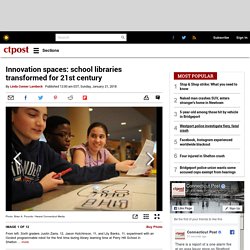
The robot has sensors that respond to specific color codes causing it to speed up, slow down, and change direction. lessFrom left; Sixth graders Justin Zarra, 12, Jason Hutchinson, 11, and Lily Banks, 11, experiment with an Ozobot programmable robot for the first time during library learning time at Perry Hill School in Shelton ... more Photo: Brian A. Pounds / Hearst Connecticut Media Photo: Brian A. Pounds / Hearst Connecticut Media. How a School Library Increased Student Use by 1,000 Percent.
Modern libraries: Moving from a transactional to a relational library. 4 important spaces every modern library should have. There is a promising potential in making use of the library’s services in new ways.
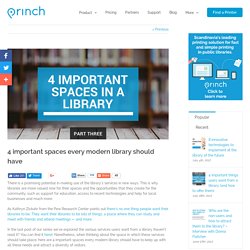
This is why libraries are more valued now for their spaces and the opportunities that they create for the community, such as support for education, access to recent technologies and help for local businesses and much more. As Kathryn Zickuhr from the Pew Research Center points out there’s no one thing people want their libraries to be. They want their libraries to be lots of things, a place where they can study and meet with friends and attend meetings — and more. In the last post of our series we’ve explored the various services users want from a library (haven’t read it? You can find it here). 1. A recent report from Pew Research Center data on US library attendance interestingly shows that millennials are the most frequent visitors to a public library, with 53% of survey respondents ages 18-35 visiting a public library or bookmobile in 2016.
DOKK1 Library Areas 2. So why forget about it? 3. 4. Is a library without books still a library? Some thoughts on The Library as space. Text of my talk at The Danish Research Library Associations Winter Assembly 2017, Korsoer, Denmark.

I like people. Not all people but in general. I strongly believe that people talking to each other, sharing ideas, challenging one another on believes and arguments makes this world a better place. The landscape of human beings interacting has changed. The rise of social media platforms as a arena for sharing of opinions has change the way we talk to each other. We must never stop talking and listening to each other. I will, using our Data Lab at the Faculty of Social Sciences Library as a case, talk about the library as both a physical and mental platform for dialog between people in order to support research, education and learning by bringing people together.
Historically we see two counterpoints: Knowledge is power and information sets you free. I jump to one of my favorite periods in history, the Enlightenment. We don’t have patent on these thoughts. The librarians role Skills? Thanks. What Does the Next-Generation School Library Look Like? At a time when public libraries are starting to offer everything from community gardening plots to opportunities to check out humans for conversations, some school libraries are similarly re-evaluating their roles and expanding their offerings.
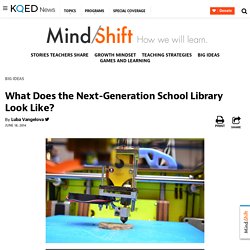
Case in point: Monticello High School in Charlottesville, Virginia. When librarian Joan Ackroyd arrived there four years ago, she found an environment very different from the “engaging, creative, fun” elementary and middle school libraries to which she was accustomed. “Its library was none of those things,” she recalls. “It was a traditional, quiet research space.” Ackroyd decided this wasn’t optimal. 21st-Century Libraries: The Learning Commons. Libraries have existed since approximately 2600 BCE as an archive of recorded knowledge.
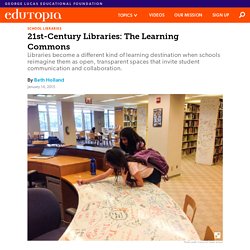
From tablets and scrolls to bound books, they have cataloged resources and served as a locus of knowledge. Today, with the digitization of content and the ubiquity of the internet, information is no longer confined to printed materials accessible only in a single, physical location. Consider this: Project Gutenberg and its affiliates make over 100,000 public domain works available digitally, and Google has scanned over 30 million books through its library project.
Libraries are reinventing themselves as content becomes more accessible online and their role becomes less about housing tomes and more about connecting learners and constructing knowledge. Library to Learning Commons - Saanich School District (No. 63) Transforming school libraries into learning commons: five keys to success - Stantec. By Michael Corb, Senior Associate (Butler, PA) The pressures on our school communities never seem to relent.
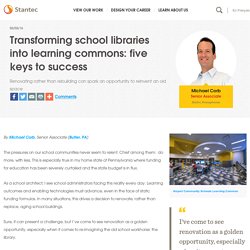
Chief among them: do more, with less. This is especially true in my home state of Pennsylvania where funding for education has been severely curtailed and the state budget is in flux. Transforming school libraries into learning commons: five keys to success - Stantec. By Michael Corb, Senior Associate (Butler, PA) The pressures on our school communities never seem to relent.
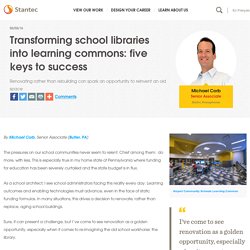
Chief among them: do more, with less. This is especially true in my home state of Pennsylvania where funding for education has been severely curtailed and the state budget is in flux. As a school architect, I see school administrators facing this reality every day. Learning outcomes and enabling technologies must advance, even in the face of static funding formulas.